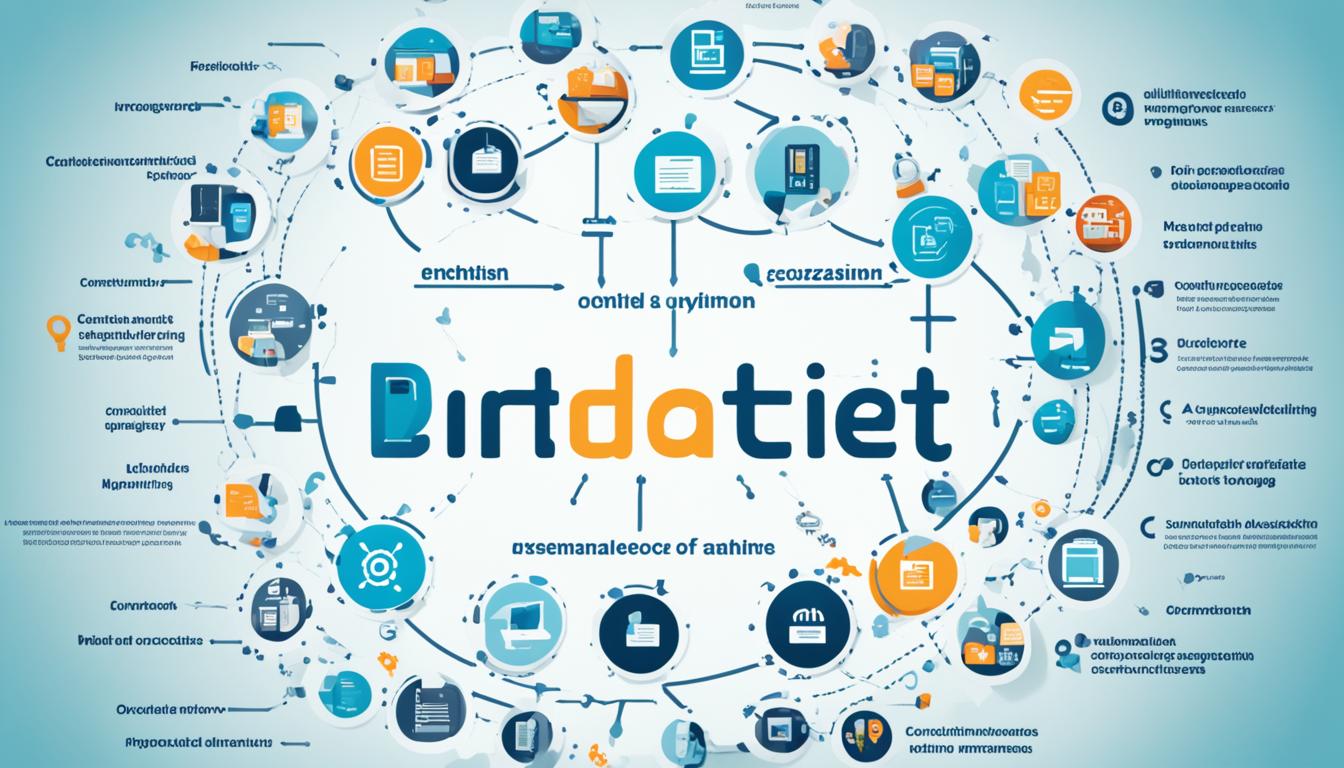Micro segmentation is a key strategy for businesses to understand their audience better. It lets companies divide their market into smaller groups with similar traits. This way, they can craft messages and products that meet each group’s specific needs and likes.
At the heart of micro segmentation is defining the target audience. Businesses analyze customer data to spot distinct groups within the broader market. By understanding the demographics, needs, and buying habits of each group, companies can create marketing that speaks directly to them.
Such a personalized approach boosts customer engagement and conversion rates. It’s about sending the right message to the right people at the perfect time. This smart strategy greatly increases a business’s marketing effectiveness.
Customer segmentation techniques are essential in micro segmentation. They involve looking at customer behavior, demographics, and mindsets. This information helps businesses build detailed profiles or personas for different segments. Understanding each persona lets companies design marketing campaigns that really appeal to those specific groups.
Adopting micro segmentation brings many advantages for companies. It not only boosts customer happiness and loyalty but also elevates ROI. Micro segmentation enables businesses to shine in crowded markets by offering personalized experiences that truly connect with their audience.
Key Takeaways:
- Micro segmentation involves dividing customers or markets into smaller, more specific groups based on common characteristics.
- Target audience segmentation is an essential part of micro segmentation, enabling businesses to tailor their marketing strategies to each segment.
- Customer segmentation techniques, such as creating customer personas, help businesses gain a deeper understanding of their target audience.
- Micro segmentation allows for highly targeted and personalized marketing campaigns, resulting in higher customer engagement and conversion rates.
- Implementing micro segmentation can lead to benefits such as increased customer satisfaction, loyalty, and improved ROI.
What is Micro Segmentation?
Micro segmentation is a method where customers or markets are split into smaller, specific groups. These groups have shared characteristics. Unlike broad segmentation, micro segmentation looks closely at behaviors, demographics, and psychographics to reach individuals.
This strategy lets companies understand what each customer segment truly needs and wants. By focusing on these unique aspects, businesses can deliver personalized experiences. These custom experiences boost customer happiness and loyalty.
Micro segmentation takes a deep dive into what individual customers like and do. It finds common qualities in customer segments. Then, it uses these insights to make marketing campaigns that really speak to people.
Benefits of Micro Segmentation:
- Highly targeted marketing campaigns
- Improved customer satisfaction
- Increase in customer loyalty
- Enhanced personalization
- Higher return on investment (ROI)
With micro segmentation, companies can fine-tune marketing to match each customer group’s unique tastes and needs. This brings personalized messages and experiences. So, it helps form stronger connections with customers.
It also lets companies shape their marketing content, offers, and deals to fit each segment perfectly. Such tailored efforts make customers more likely to buy again and again. This boosts sales and customer engagement.
To do micro segmentation right, companies need to collect and study customer data. They then define different customer groups and craft specific marketing for each one. By constantly checking the results, businesses can keep making their marketing better.
Image: Micro Segmentation
| Market Segmentation | Micro Segmentation |
|---|---|
| Divides customers into broad groups based on general characteristics | Divides customers into smaller, more specific groups based on shared characteristics |
| Approach focuses on targeting a larger population with similar needs and preferences | Approach focuses on targeting individual segments with personalized marketing strategies |
| Less targeted marketing campaigns | Highly targeted marketing campaigns |
| Less personalized customer experiences | More personalized customer experiences |
| May result in lower ROI due to lower relevance | May result in higher ROI due to increased relevance |
Benefits of Micro Segmentation in Marketing
Micro segmentation makes marketing much more effective. It divides customers into smaller groups with similar needs or interests. This way, companies can create unique marketing campaigns for each group. These focused efforts lead to more customers and better ROI.
Customized experiences are a big plus of micro segmentation. Companies learn what each customer group likes. They then make marketing strategies that meet these specific needs. Happy customers become loyal ones, which is good for business.
This strategy also helps in selling more to current customers. Companies figure out what different groups might like to buy. Then, they offer products or services that fit those interests. This method increases sales and builds customer loyalty.
Another benefit is keeping customers from leaving. Companies can spot which groups might not be happy and why. They then work to fix these problems with tailored solutions. This reduces the number of customers leaving and keeps the customer base strong.
To wrap it up, micro segmentation has lots of advantages. It can boost sales, make ROI better, and improve how customers see a brand. Plus, it helps keep customers coming back and reduces the chance of them leaving. By paying attention to what each customer group needs, companies can succeed in the long run.
Implementation Strategies for Micro Segmentation
To implement micro segmentation well in marketing, you need a good plan and action. Here are main strategies for doing micro segmentation the right way:
1. Define Customer Segments
The first task is to identify customer segments with relevant details. Use data like demographics, buying history, and behavior to spot different groups among your audience.
2. Gather Customer Data
Collect important data from sources like surveys, social media, and sales records. This information helps understand what customers like and do, helping to aim marketing better.
3. Create Customer Personas
After defining segments and collecting data, make customer personas for each. These personas show common features among segment members. They help understand the audience better and adjust marketing to fit them.
4. Develop Targeted Marketing Campaigns
With customer personas ready, design marketing campaigns for each segment’s needs and likes. Make personalized messages and offers. This increases how well your marketing works.
5. Track and Evaluate Key Metrics
It’s vital to track and check key metrics to see if your micro segmentation works. Watch metrics like how many new customers you get, rate of buying, how long customers stay, and how happy customers are. Use this info to see what needs to get better and adjust your marketing as needed.
By following these steps, you can use micro segmentation to make marketing more successful and relevant to your audience.
| Customer Segment | Characteristics | Marketing Campaign |
|---|---|---|
| Segment A | Young professionals, tech-savvy, urban dwellers | Social media-focused campaign highlighting the latest technology trends |
| Segment B | Parents, family-oriented, value-conscious | Email campaign offering discounts on family-friendly products |
| Segment C | Retirees, travel enthusiasts | Content marketing campaign featuring popular travel destinations |
Examples of Micro Segmentation in Marketing
Micro segmentation is a powerful strategy in marketing. Many companies use it to make their marketing better. Companies like Pepper Content and Notion are great examples of its success.
Pepper Content
Pepper Content is a leader in providing content marketing services. They have mastered micro segmentation. They split their services into different areas for various content needs.
They offer services like blog translation, email design, and website translation as unique offerings. This lets clients pick what they really need. It ensures each client gets content services tailored to their specific goals and preferences.
| Pepper Content Micro Segmentation Examples |
|---|
| Blog Translation |
| Email Design |
| Website Translation |
Notion
Notion is popular for its note-taking software. It practices micro segmentation in its marketing. Notion categorizes its users by industry, company size, and job profile.
It offers unique templates and solutions to diverse sectors. For example, they have specific features for creatives, tech firms, and schools. This approach makes Notion’s solutions more relevant and effective for each user group.
| Notion Micro Segmentation Examples |
|---|
| Creative Industries |
| Tech Companies |
| Educational Institutions |
Pepper Content and Notion show micro segmentation’s effectiveness in different sectors. By focusing on targeted segments, companies can offer products and services that meet each customer’s unique needs. This leads to better customer satisfaction and business success.
Macro Segmentation vs. Micro Segmentation
In marketing, knowing your audience is key. We have two main ways to do this: macro and micro segmentation. They help us understand and reach people, but they work differently. Macro looks at the big picture, while micro gets into the details.
Macro segmentation groups customers or markets into big sections. This is based on wide factors like location or size. It helps us see the big trends and create general marketing plans. For instance, an online shop might see where its customers live. Then, they can make special ads just for those areas.
Micro segmentation goes way deeper. It looks at what people buy, their age, and even lifestyle to learn about them. With this info, companies can find and talk to smaller, specific groups. A clothes store could notice what styles different ages like. Then, they could send them special deals.
The table below shows how different macro and micro are:
| Macro Segmentation | Micro Segmentation |
|---|---|
| Divides customer base into larger segments | Classifies customers into smaller, more specific segments |
| Based on broad characteristics such as location, industry, and size | Based on purchasing behavior, demographics, and psychographics |
| Provides a high-level understanding of the customer base | Allows for a deeper understanding of each customer segment’s unique characteristics |
| Enables broad marketing strategies and identification of general market trends | Enables personalized marketing strategies and targeted campaigns |
Using both macro and micro helps businesses fully understand their customers. This means they can meet everyone’s needs better. With this smart combination, marketing can be more effective and reach everyone more closely.
Segmentation Variables in Micro Segmentation
In micro segmentation, companies divide customers into smaller groups using different variables. These variables help understand what each customer segment needs and likes. This way, companies can make marketing that really speaks to these groups, offering them what they want.
Segmentation variables in micro segmentation include:
- Demographics: Age, gender, and income are important to create a clear picture of various customer groups.
- Product Usage: Looking at what customers buy and like helps companies offer more of what they want.
- Buying Behavior: Understanding how often people shop and what they choose helps tailor company strategies.
- Situational Factors: Things like how urgent an order is and how big it is show what customers need right now.
Using these variables, companies can really get to know their customers. This deep insight allows them to make marketing that each group will find appealing. The result is happier customers and better business outcomes.
| Segmentation Variable | Description |
|---|---|
| Demographics | Detailed information about customers’ age, gender, and income. |
| Product Usage | Insights into customers’ preferences and purchase history. |
| Buying Behavior | Understanding how often customers make purchases and their preferences. |
| Situational Factors | Taking into account variables such as urgency and order size to cater to immediate needs. |
How to Implement Micro Segmentation in Marketing
Micro segmentation in marketing means using customer data to divide them into specific groups. It involves making customer personas and crafting targeted campaigns. These are designed for the unique needs and likes of each group.
The first step is to collect customer data. This data comes from surveys, social media, and transactions. By studying this data, firms can spot trends and traits to define segments.
After defining segments, the next task is to make customer personas. These personas show what each segment has in common. They outline their needs, likes, and actions. This makes it easier for marketers to understand their audience and craft strategies that hit the mark.
With customer personas ready, it’s time to launch targeted campaigns. These campaigns must cater to the distinct needs and likes of each segment. They should offer personalized messages and experiences that really stand out. Doing this helps firms connect more deeply with their audience, boosting engagement and conversions.
For micro segmentation to work, tracking key metrics and checking how strategies perform is vital. This helps firms see how effective their campaigns are. They can identify what needs tweaking to improve results. Keeping an eye on these metrics helps refine marketing strategies for the best impact.
To sum up, micro segmentation needs a planned approach. This includes gathering data, making personas, and launching targeted campaigns. By tailoring marketing to each segment, companies can better engage their audience. This leads to more conversions and marketing success overall.
Best Practices for Micro Segmentation in Marketing
When doing micro segmentation in marketing, following best practices is crucial. This ensures you get the best outcomes. Companies focus on key customer segments to develop targeted strategies. These strategies meet their unique needs and desires. Here are some key best practices:
1. Identify Valuable Customer Segments
First, figure out which customer segments matter most to your business. Look at their buying history, behavior, and demographics. This helps you understand them better. With this insight, you can design marketing efforts that really speak to them.
2. Test and Experiment
It’s important to try different strategies to see what works best. Do A/B tests, mix up messages and offers, and watch the outcomes. This lets you improve your tactics. You’ll find what most affects each customer group.
3. Track Key Metrics
Keeping an eye on key metrics tells you if your micro segmentation works. Check things like how many new customers you get, how many stick around, their overall value, and how happy they are. This information helps you tweak your strategies for better results.
4. Prioritize Personalization and Customization
Personalization is at the heart of micro segmentation. Make your marketing efforts fit each customer segment’s needs and likes. Use what you know about them for personalized touches like targeted suggestions and offers made just for them. This makes their experience better and boosts engagement.
5. Continuously Optimize and Adapt
Always be ready to make your strategies better when it comes to micro segmentation. Regularly review how your marketing is doing, find spots to improve, and adjust as needed. Keep up with changes in customer tastes, market shifts, and new industry standards. This keeps your approaches effective.
By sticking to these best practices, businesses can use micro segmentation for marketing that really connects. This leads to happier customers, more engagement, and, in the end, growth for the company.
The Impact of Micro Segmentation in Marketing
Micro segmentation significantly changes marketing strategies. It helps companies understand what different customer groups want and need. This leads to marketing campaigns that resonate more with people, resulting in higher sales and better returns on investments.
Micro segmentation’s strength lies in making marketing personalized. Companies can craft special messages for each customer group. This makes customers happier and more loyal. They feel important when their unique preferences are recognized, creating a stronger bond with the brand.
It also makes it easier to sell more to each customer. Knowing what different groups like helps companies suggest products that people are more likely to buy. This strategy not only increases sales but also makes each customer more valuable over time.
Moreover, micro segmentation helps keep customers. It allows companies to see who might leave and why. Then, they can act to keep these customers happy. This approach saves money and keeps the customer community strong.
| Benefits of Micro Segmentation in Marketing |
|---|
| Higher conversion rates |
| Increased customer satisfaction |
| Improved ROI |
| More effective upsell and cross-sell campaigns |
| Reduced customer churn |
| Enhanced customer lifetime value |
The benefits of micro segmentation in marketing are immense. With the right data, companies can fine-tune their marketing to meet the exact needs of different groups. This results in better marketing success and fantastic customer experiences.
Conclusion
Micro segmentation in marketing is a strong tool. It helps companies understand their customers better and make tailored marketing plans. By breaking down customers into smaller groups, companies can target their marketing better. This leads to more customers saying yes, happier customers, and better returns.
To use micro segmentation, companies must figure out customer groups based on data. They create customer personas for each group. These personas help in making marketing that meets the unique wants and likes of each group. Companies track their progress and tweak things to get even better results.
Nowadays, making customers happy is key to marketing success. Micro segmentation lets companies offer a more personal experience. This makes customers more loyal and satisfied. By meeting the exact needs and wants of each customer group, companies can send marketing that really matters to their customers.
In summary, micro segmentation is a great marketing strategy. It lets companies get to know their customers, make marketing just for them, and succeed in business. By tapping into micro segmentation, companies can make customers happier, refine their marketing, and reach their goals.







